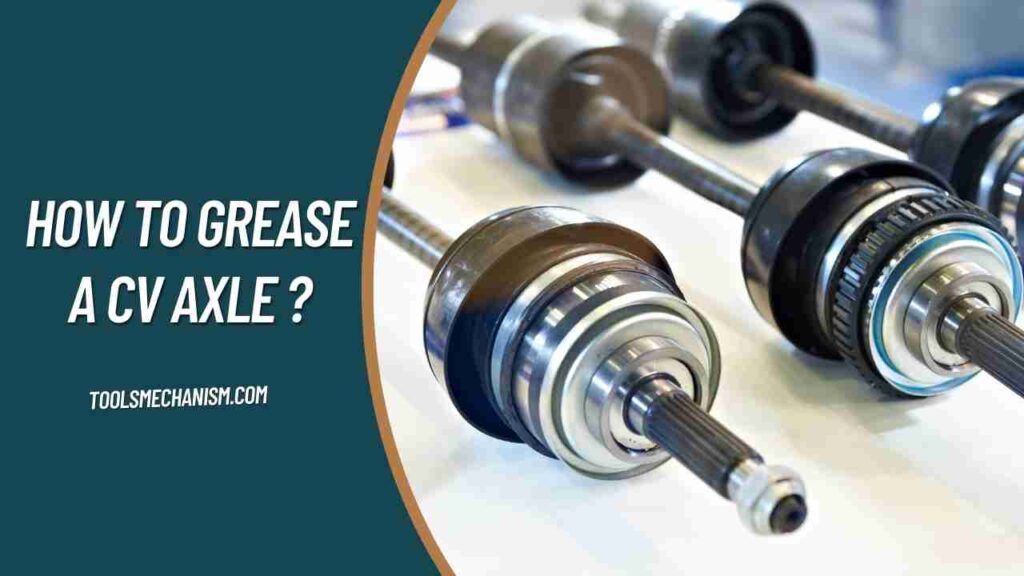Never underestimate the fact that every rotatory part of automobiles needs lubrication. Indeed, the differential parts of vehicles are not left out in any way in this discourse.
The axle is part of the differential system that’s connected to the wheels. Its presence is conspicuous in front-wheel and four-wheel drive vehicles. All these require lubrication from the axle assembly to the piston, shafts, and gears.
Of course, this differential system enables you to control the wheels at different speed rates, and you must grease the transmission part of the differential system, which includes the axle assembly, to get the apt inference.
Thus, the differential system is connected to the transmission through the driveshaft. Notwithstanding, the part of the axle assembly that’s connected to these two compartments is the CV axle.
How to Grease a CV Axle? 7 Easy Steps
- The essential part is accessing the axle assembly at the vehicle’s front and rear. Therefore, start by getting the wrenches and screwdrivers needed available.
- Remove the battery terminals and remove the battery from the bonnet. Use the wrench to remove the wires from their respective terminals.
- Next, you’re to disconnect the brake line of the vehicle. Use the 14mm wrench to loosen the banjo bolt on the strut or central pipe where the brake may be found and disconnect the brake line thereafter.
- You should access the axle assembly once you remove the wheel caliper, intuitively remove the nuts that hold each CV axle, and access the CV joint.
- Take hold of the boot and remove old grease by inverting its position to enable the grease to flow out. Check the boot and see if it hasn’t turned or become damaged.
- Use a brush to clean the dirt that may be cleaving on the rubberized sleeve of the axle. You can also use the tip of the screwdriver to remove rusts lingering on the joint. This should be done on all the CV axles of the car to scoop the correct result.
- Use your grease gun to infuse new grease into the protective layer. Tighten up the bolt and fix the CV axle back to its former position while you reassemble the whole compartment of the vehicle.
What is a CV Axle?
The CV axle is fully called the constant velocity axle. It connects the wheel’s sensitivity through the differential components to the transmission.
It’s acknowledged as the essential sensor collector that keeps the speed rate of front wheels constant per time. The CV axle is the shaft often found at the front wheel and sometimes the back wheel. There are boots on the sides of the CV axles.
The boots are rubberized with sleeve designs, connected to the wheels on both sides of the vehicle. A rod often separates the middle of the two ends of each axle. As it’s been called, the half shaft is partially connected to the transmission to enable the other end to turn the tires quickly as controlled through the driveshaft.
What Does the CV Axle do?
They are present in front-wheel and four-wheel vehicles. They are part of the axle assembly that makes the wheels turn at a constant velocity.
The engine power is conveyed to the wheel through the axle. The essence is to give the wheel the proportional torque power emanating from the engine through the transmission to get the wheels revving.
It’s the boot you’re to grease to boost the performance of the CV joint. The joint protrudes from the CV boot on both sides of the vehicle, and it’s nut to the wheels to give it the control required. The boot is sealed with either rubber or plastic to prevent the permeation of dirt or water.
Do You Need to Grease CV Axles?
Yea, you’re to grease CV axles to maintain the performance of the suspension system and the vehicle’s differential system.
In fact, clinking sounds emanate once the axle isn’t lubricated. If the lubrication isn’t done on time, you could find CV joints splatter on brakes, wheels, shock absorbers, and so on.
Obviously, greasing the CV joint on time is extremely important to prevent further spoilage of some essential parts of the vehicle. The grease keeps the protective layers intact while they spin.
Beyond the mere greasing of the axle, lubricating the CV axle properly is crucial to get a lasting result. Use suitable grease for your CV axle.
What Grease to Use in CV Axle?
Lithium grease is the most suitable grease for CV joints. You wouldn’t want to use oil because it could ebb out of the boot. The protective layers in the boot require lithium grease because they can withstand high temperatures and enable them to slide smoothly.
The graphite and molybdenum constituents give optimum thermal stability. It could withstand a temperature of 260 degrees Fahrenheit.
Furthermore, lithium grease is waterproof and recommended for heavy-duty lubrication. Buy from a reliable source to have an appreciable result.
How much Grease Goes in a CV Axle?
This could be done cognitively. You’re not to fill the axle to the brim. All that’s needed is to ensure the moving part of the CV joint is greased. Some new CV axles come with grease in a sachet enough to lubricate the moving parts in the joint’s protective layers. Better still, you can use the grease gun to apply the lubricant.

Final Words
Follow these instructions, and you’ll arrive at the juncture of your expectation. Don’t lubricate haphazardly. Moreover, don’t wait for the axle to screech before applying the grease. Instead, lubricate all the boots simultaneously to scoop the ultimate result.
Nevertheless, don’t hesitate to dispose of the CV axle if the rubberized sleeve is turned or damaged.Trash it and replace it with a new one as soon as possible.

